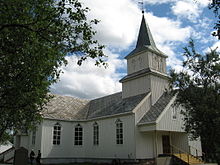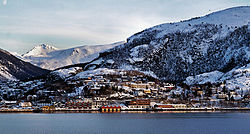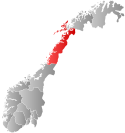|
Meløy Municipality
Meløy is a municipality in Nordland county, Norway. It is part of the Salten traditional region. The administrative centre of the municipality is the village of Ørnes. Other villages include Eidbukt, Neverdal, Glomfjord, Halsa, Reipå, Støtt, and Ågskardet. The municipality is situated just to the north of the Arctic Circle on Norway's west coast. It encompasses the island of Meløya and some 700 other islands of various sizes around the Meløyfjorden, Glomfjorden, and Holandsfjorden in the south, along with a stretch of mainland coast. The 874-square-kilometre (337 sq mi) municipality is the 133rd largest by area out of the 357 municipalities in Norway. Meløy is the 157th most populous municipality in Norway with a population of 6,180. The municipality's population density is 7.1 inhabitants per square kilometre (18/sq mi) and its population has decreased by 4.8% over the previous 10-year period.[5][6] General information   The municipality of Meløy was established on 1 January 1884 when the large Rødøy Municipality was divided into two: Rødøy Municipality (population: 1,945) in the south and Meløy Municipality (population: 2,696) in the north. The municipal borders have not changed since then.[7] NameThe municipality (originally the parish) is named after the island of Meløya (Old Norse: Mjǫlva) since the first Meløy Church was built there. The first element comes from the word mjǫl which means "flour" or "meal" (referring to fine sand on the beaches of the island). The last element (which was added to the name around the year 1500) is øy which means "island".[8] Historically, the name of the municiaplity was spelled Melø. On 6 January 1908, a royal resolution changed the spelling of the name of the municipality to Meløy.[9] Coat of armsThe coat of arms was granted on 7 December 1984. The official blazon is "Azure, a poppy plant Or" (Norwegian: I blått en gull valmueplante). This means the arms have a blue field (background) and the charge is a subspecies of the arctic poppy plant locally known as Svartisvalmue (Papaver radicatum subglobosum). The poppy plant has a tincture of Or which means it is commonly colored yellow, but if it is made out of metal, then gold is used. The municipality is located near the second largest glacier in continental Norway, the Svartisen (black ice), and the plant is one of the plants found growing closest to the ice. The colors symbolize the blue glacial ice and the yellow flowers. The arms were designed by Rolf Tidemann after the original ideda by Knut Sørensen.[10][11][12] ChurchesThe Church of Norway has three parishes (sokn) within Meløy Municipality. It is part of the Bodø domprosti (arch-deanery) in the Diocese of Sør-Hålogaland.
History Meløy has been inhabited for many centuries and still possesses various relics from the Viking Age. The Benkestok family, one of Norway's original noble families, established one of its seats at Meløy gård (farm) on the island of Meløya in the 16th century. Due to the expansion of the population during the 19th century, the area of Meløy was split from its southern neighbour, Rødøy Municipality, in 1884. Its administrative centre was originally on Meløya, but it was later moved to the mainland coastal village of Ørnes. Ørnes is one of the stops on the route of the Hurtigruten (coastal express boat), with a notably scenic entrance via the fjord. The second largest glacier in Norway, Svartisen, is a target for passenger visits. The mountains around Glomfjord are popular for fishing and hunting as well as skiing in the winter time. GovernmentMeløy Municipality is responsible for primary education (through 10th grade), outpatient health services, senior citizen services, welfare and other social services, zoning, economic development, and municipal roads and utilities. The municipality is governed by a municipal council of directly elected representatives. The mayor is indirectly elected by a vote of the municipal council.[13] The municipality is under the jurisdiction of the Salten og Lofoten District Court and the Hålogaland Court of Appeal. Municipal councilThe municipal council (Kommunestyre) of Meløy is made up of 23 representatives that are elected to four year terms. The tables below show the current and historical composition of the council by political party.
MayorsThe mayor (Norwegian: ordfører) of Meløy is the political leader of the municipality and the chairperson of the municipal council. Here is a list of people who have held this position (incomplete list):[33]
Geography The municipality of Meløy is a coastal community that includes many of the surrounding islands. Many parts of the mainland were fairly isolated until road tunnels were built during the 20th century that connected them to the rest of Norway. Some of the main islands of Meløy are Åmøya, Meløya, Bolga, Mesøya, Grønøya, and Støtt. Åmøya is connected to the mainland via the Brattsund Bridge. The other islands are all accessible by boat or ferry only. The Kalsholmen Lighthouse is located in the southwestern part of the municipality. The Vestfjorden passes Meløy in the northwest, and the Meløyfjorden, Glomfjorden, and Holandsfjorden cut into the mainland from the west. The Saltfjellet–Svartisen National Park is located in the southeast in the Saltfjellet mountain range, surrounding the Svartisen glacier. The highest point in the municipality is the 1,636.81-metre (5,370.1 ft) tall mountain Skjelåtinden, on the border with Beiarn Municipality.[1] Farms of MeløyHistorically, the land of Meløy was divided up into named farms. These farms were used in census and tax records and are useful for genealogical research. Meløy municipality, tellingskrets 1-8 from 1920 census Tellingskrets (enumeration districts): 1, Bolga (lime); 2, Åmnes (black); 3, Herstad (blue); 4, Aag (purple); 5, Holand (green); 6, Sneland (red); 7, Halsa; (teal) 8, Bjerangen (gray). List of farms: 1 1: Smyen2 2: Bolga3 77: Kalsholm fyr4 4: Tind5 5: Kjørhaugvik6 6: Vikvoll7 7: Åmnes8 8: Stavnes9 39: Grønøy10 9: Skaret11 10: Herstad12 3: Voldvik13 17: Rendalsvik14 18: Fondal15 19: Engen16 22: Brasett17 23: Sommerseth18 24: Aspnes19 20: Myrvold20 21: Storvik21 25: Skålsvik22 26: Halsa23 27: Æsøy24 28: Slætan25 29: Grønaas26 30: Breivik27 31: Bjerangen28 Halsa kirke (church), built 1960 Meløy municipality, tellingskrets 9-16 
4km
2.5miles
58: Glomfjord kirke
57: Ørnes kirke
56: Fore kirke
55: Meløy kirke 54 53
52
51 50 49 48 47 46 45 44 43 42 41 40 39 38 37 36 35 34 33
32
31 30 29 28 27 26 25 24 23 22 21 20
19
18 17 16 15 14 13 12 11 10 9 8 7 6 5 4 3
2
1 Tellingskrets (enumeration districts): 9, Enga (lime); 10, Vasdal (teal); 11, Glomfjorden (blue); 12, Øbugt (purple); 13, Spildra (green); 14, Nordbygden (red); 15, Stol (black); 16, Meløy (gray). List of farms: 1 32: Kjeldal2 33: Angelsheim3 34: Oldra4 35: Saura5 36: Osa6 37: Enga7 38: Valla8 40: Fokeng9 41: Jenslund10 42: Vasdal11 43: Sandvik12 45: Glommen13 46: Hugvik14 44: Reindalen15 48: Selstad16 49: Næverdal17 50: Saudå18 51: Øbugt, nedre19 52: Øbugt, yttre20 53: Borvik21 54: Vollvik22 84: Silvik23 85: Balsethvandet24 86: Rauseth25 55: Korsnes26 56: Spildra øvre27 57: Spilderdalen28 58: Digermulen29 59: Vinterveien30 60: Djupvik31 61: Mosvoll32 62: Løvset33 63: Torsvik34 64: Gjerset35 65: Teksmo36 83: Mesøy37 66: Stien38 67: Ronemoen39 68: Sør Fore40 69: Sæterenget41 70: Dalen42 71: Kleiven43 72: Kunna44 73: Støtt45 74: Gaasvær46 75: Otervær47 76: Skagen48 77: Meløysjøen49 78: Vanvik50 79: Røshagen51 80: Fagervik52 81: Risvik53 82: Meløsund54 87: Skjærpvik55 Meløy kirke (church), built 186756 Fore kirke (church), built 190957 Ørnes kirke (church), built 199058 Glomfjord kirke (church), built 1957 Coordinates on the maps are approximate. Each map has a maximum number of listings it can display, so the map has been divided into parts consistent with the enumeration districts (Norwegian: tellingskrets) in the 1920 census of Norway. This map will include one farm name per farm number; other farm names or subdivision numbers may exist. Farm names and numbersFollowing are the farms in the Meløy municipality, as they are listed in O. Rygh's series Norske Gaardnavne (lit. 'Norwegian farm names'), the Nordland volume of which was published in 1905.
The farm numbers are used in some census records, and numbers that are near each other indicate that those farms are geographically proximate. Handwritten Norwegian sources, particularly those prior to 1800, may use variants on these names. For recorded variants before 1723, see the digital version of O. Rygh. Note that the 1920 census records mapped above may not match O. Rygh. Farm names were often used as part of Norwegian names, in addition to the person's given name and patronymic or inherited surname. Some families retained the farm name, or toponymic, as a surname when they emigrated, so in those cases tracing a surname may tell you specifically where in Norway the family was from. This tradition began to change in the mid to late 19th century, and inherited surnames were codified into law in 1923.
EconomyThe industrial development—and thus the main contributor to the economic development and growth of the Meløy community—started around the time of World War I. It was based on electrical power production in then new Glomfjord power plant from water coming from the Svartisen glacier and the lake Storglomvatnet and gathered in the mountains. In the bottom of Glomfjorden, Norsk Hydro (today YARA) started out producing fertilizers in Glomfjord, today yara is Meløy's biggest workplace with 190 people working there A conglomerate of industries is found there today in Glomfjord Industry Park. The municipality's overall industries are some light industry, agriculture, forestry, fishing, salmon production, and tourism. Meløy Energi, an electrical power company, is one of the most important employers in the municipality (as of Q4 2022).[40] Notable people
References
External links
|
||||||||||||||||||||||||||||||||||||||||||||||||||||||||||||||||||||||||||||||||||||||||||||||||||||||||||||||||||||||||||||||||||||||||||||||||||||||||||||||||||||||||||||||||||||||||||||||||||||||||||||||||||||||||||||||||||||||||||||||||||||||||||||||||||||||||||||||||||||||||||||||||||||||||||||||||||||||||||||||||||||||||||||||||||||||||||||||||||||||||||||||||||||||||||||||||||||||||||||||||||||||||||||||||||||||||||||||||||||||||||||||||||||||||||||||||||||||||||||||||||||||||||||||||||||||||||||||||||||||||||||||||||||||||||||||||||||||||||||||||||||||||||||||||||||||||||||||||||||||||||||||||||||||||||||||||||||||||||||||||||||||||||||||||||||||||||||||||||||||||||||||||||||||||||||||||||||||||||||||||||||||||||||||||||||||||||||||||||||||||||||||||||||||||||||||||||||||||||||||||||||||||






